Harris C.M., Piersol A.G. Harris Shock and vibration handbook
Подождите немного. Документ загружается.


Specific Damping Energy. Another useful measure of material damping is the
amount of energy dissipated per unit volume per cycle, known as the specific damp-
ing energy. For a damping material specimen subject to an applied external force
F(t) = F
0
cos ωt the specific damping energy D is equal to
D =
F dx =
2π/ω
0
Fdt (37.21)
For a viscoelastic material obeying Eq. (37.7)
D = F
0
x
0
kη
1
+
η
2
(37.22)
But F
0
= kx
0
1
+
η
2
, also from Eq. (37.7), so
D =πx
0
2
kη (37.23)
The specific damping energy D increases as the square of the amplitude of vibration
x
0
for linear viscoelastic materials, so it is clearly desirable to ensure that the damp-
ing material is strained as vigorously as possible in order to maximize D and hence
the damping of the system. This has an important bearing on the choice of location
within a vibrating system for application of a damping treatment. Furthermore, both
k and η must be as large as possible to ensure maximum energy dissipation in the
system, but this can be done only to the extent that further increases of k and η do
not reduce x
0
. While D is related to k and η for linear viscoelastic materials, this is
not possible for nonlinear materials or for high cyclic strain levels where nonlinear
behavior occurs; the value of D is then, of itself, often used as a measure of overall
damping performance.
COMPARISON OF DAMPING MEASURES
The damping measures described in this section are related to each other as follows
(Table 37.2):
η=2ζ= = = = = (37.24)
These various equations relate η, ∆, and ζ for viscous and viscoelastic damping of
single degree-of-freedom systems. The relationships usually agree well for low
values of η and ζ (η<0.2 or so), but for higher values the comparisons are not so
precise.
It is important, when analyzing tests to determine the effects of damping treat-
ments on dynamic response, to be consistent in the use of these damping measures
and to recognize that they are not completely equivalent, especially over wide fre-
quency ranges or for multimodal response.
Effects of Mass and Stiffness. Changing the mass or stiffness of a single degree-
of-freedom mass-spring system without changing any other parameters leads to a
change of resonance frequency, and when the frequency changes over a wide range,
the differences of viscous and hysteretic damping become more apparent. For vis-
cous damping, the fraction of critical damping ζ=c/2
k
m
changes as k or m change,
∆ω
ω
r
1
A
D
2πU
1
Q
2∆
π
dx
dt
APPLIED DAMPING TREATMENTS 37.17
8434_Harris_37_b.qxd 09/20/2001 12:27 PM Page 37.17

whereas for hysteretic damping η does not change, at least within a limited fre-
quency range.Although viscous and hysteretic damping measures are related by the
simple relationship η=2ζ for a single mode at a particular frequency, they do not
remain equivalent as the frequency changes, and significant differences in response
may be observed.
METHODS FOR MEASURING COMPLEX MODULUS PROPERTIES
Vibrating Beam Test Methods. The vibrating beam test methods are frequently
used to measure the extensional or shear complex modulus properties of damping
materials.
1,6
The dynamic response behavior of the beam, first in the undamped
uncoated form and then with an added damping layer or added constrained configu-
ration, is measured for several modes of vibration and over a range of temperatures.
At each temperature, the measured damped resonance frequency f
n
, the undamped
resonance frequency f
on
, and the loss factor η
n
in the nth mode of vibration are meas-
ured and used in an appropriate set of equations to deduce the Young’s modulus E, or
the shear modulus G, and the loss factor η of the damping material at a number of dis-
crete frequencies and temperatures.
Various configurations of cantilever beams are used to measure viscoelastic
material damping properties in tension-compression or shear at low cyclic strain
amplitudes. Figure 37.11 illustrates some of the configurations used. The damping
layers are bonded to the base beams by means of a stiff adhesive such as an epoxy.
This bonding is very important and must be done well using an adhesive which is
stiff in comparison to the damping layer and is very thin. The thickness ratio h
2
/h
1
generally lies in the range 0.1 ≤ h
2
/h
1
≤ 2.0, and the length l is about 5 to 10 in. (12.7
to 25.4 cm). The base beam material is typically aluminum, steel, or a stiff epoxy or
epoxy matrix composite material having low intrinsic damping. Great care must be
taken to ensure that the temperature range of the tests is not excessive in relation to
the behavior of the base beam, and in particular to allow for the effect of tempera-
ture on the base beam properties such as Young’s modulus, the resonance frequen-
cies, and the modal loss factor in the absence of the damping layer.The vibration test
is conducted allowing the specimen to soak at each selected temperature for several
minutes, often 30 minutes, to be sure of thermal equilibrium; then the beam is
excited by means of a noncontacting transducer or by impact, and the resulting
response in the frequency domain is measured, either through swept sine-wave exci-
tation or FFT analysis of the transient response signal in the time domain. At each
temperature, several resonance frequencies and modal loss factors are measured
over a wide range of frequencies.The test is then repeated after thermal equilibrium
has been reached at the next selected temperature. The data obtained for the first
mode is usually not used because of the low frequency involved and the high ampli-
tudes and high modal damping of the base beam, as well as because of errors in the
analysis when sandwich beams are used. Such vibrating beam tests are widely used
for measuring viscoelastic material damping properties for shear and extensional
deformation.
9,10
Geiger Thick-Plate Test Method. The Geiger thick-plate method is of impor-
tance because it is widely used to describe damping materials in the automotive
industry. It makes use of a large flat plate, suspended freely from four points selected
to be at or near the nodal lines of the first free-free mode, to which is bonded the
damping layer being evaluated. The rate of decay of vibration amplitude (expressed
in decibels per second) is measured and serves as a measure of the effectiveness of
the damping layer. Figure 37.12 illustrates a typical test setup. The system can be
37.18 CHAPTER THIRTY-SEVEN
8434_Harris_37_b.qxd 09/20/2001 12:27 PM Page 37.18
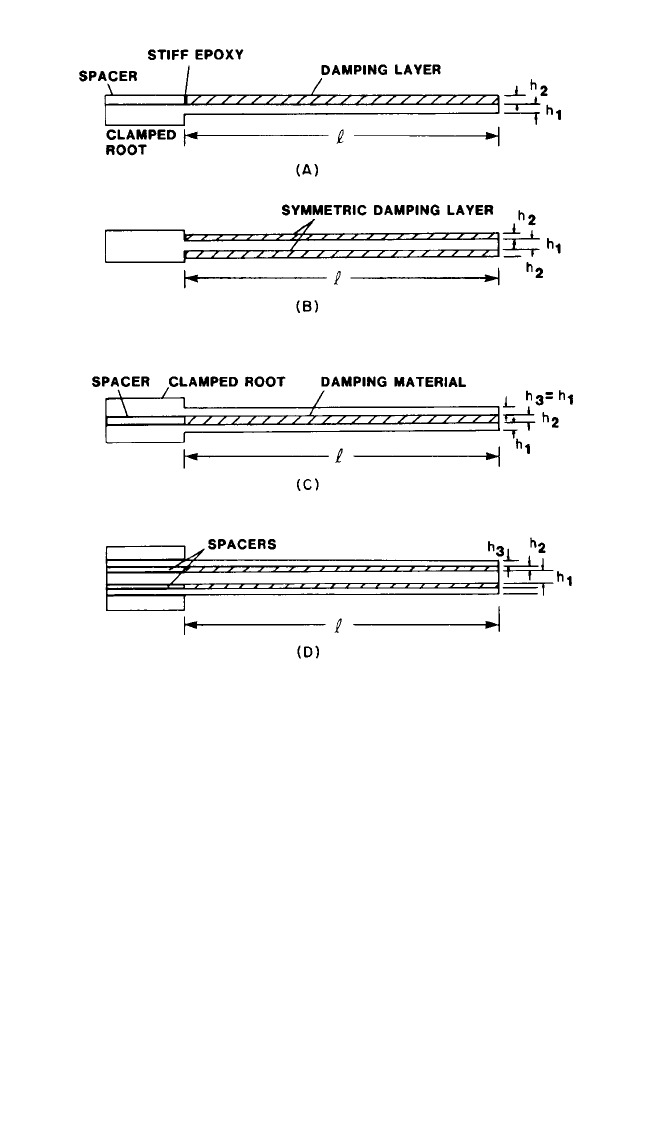
excited by an impulsive force, measured through a force gage, and applied by a
hammer, by an electromagnetic exciter, an electrically actuated impeller, or by sine-
wave or random excitation. The response can be picked up by an electromagnetic
transducer, in which case cross talk with the excitation transducer must be avoided
by adequate separation or by the use of capacitative or electro-optical transducers
or by a miniature accelerometer. The measured output can be displayed in many
ways, including a decaying sinusoidal trace representing response to an impulsive
excitation (a measure of the logarithmic decrement), or a frequency domain display
in the region of the fundamental free-free mode (loss factor measure).The observed
logarithmic decrement or loss factor value is a measure of the damping of the
plate/damping material system and depends on the plate and treatment thicknesses.
The free-layer treatment equations used for the vibrating beam tests may also be
used with the Geiger plate test provided that the same conditions are satisfied. In
particular, the treatment thickness must be sufficient to make the ratio of the
stiffness of the coated plate to that of the uncoated plate greater than about 1.05.
The size of the specimen and the use of only one mode makes this condition
somewhat less restrictive than for the beam tests, for which the specimens are much
smaller.
APPLIED DAMPING TREATMENTS 37.19
FIGURE 37.11 Cantilever beam damping material test configurations. (A)
Nonsymmetric Oberst beam. (B) Symmetric modified Oberst beam. (C)
Symmetric sandwich beam. (D) Symmetric constrained-layer beam.
8434_Harris_37_b.qxd 09/20/2001 12:27 PM Page 37.19
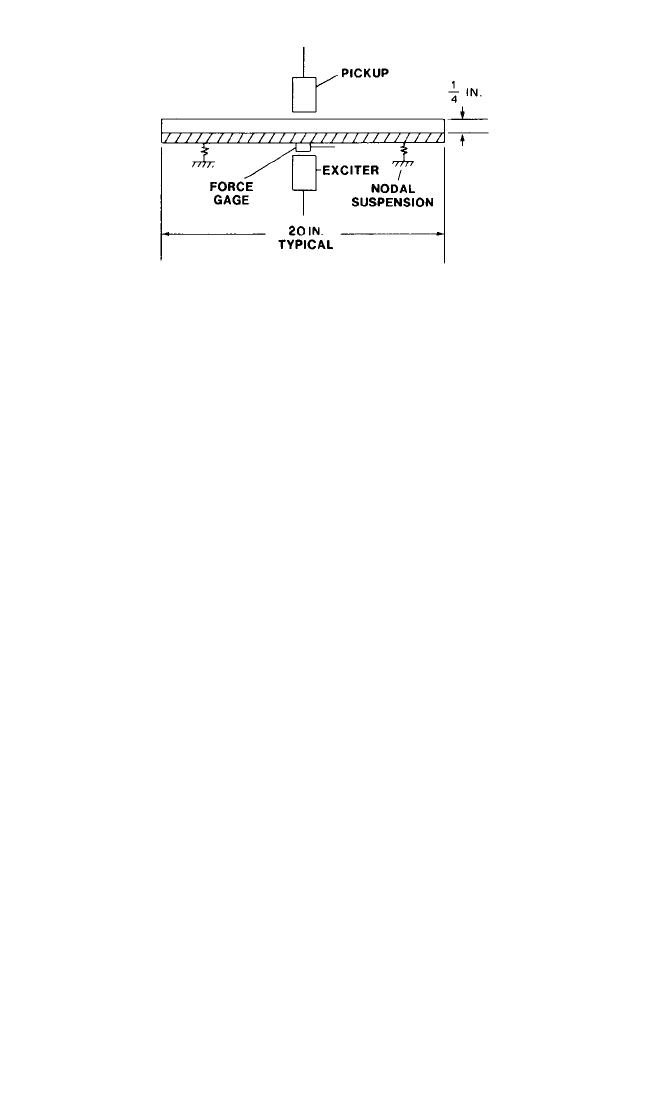
Single Degree-of-Freedom Resonance Tests. Digital test instrumentation and
data analysis techniques make it relatively easy to conduct vibration tests directly on
relatively small samples of damping materials and to readily determine the damping
properties. Typical test configurations are illustrated in Fig. 37.13. For a resonance
type of test, the specimen is driven inertially by a large vibration table (see Chap.
25), usually by swept sine-wave excitation. The input and output accelerations are
usually measured by accelerometers, and the response parameter of interest is the
amplification A = x/x
0
as a function of frequency, where x is the amplitude of dis-
placement of the mass and x
0
is that of the shaker table. At resonance, the maximum
value of A = x/x
0
is observed along with the resonance frequency ω
R
for each tem-
perature. The loss factor and modulus in both the tension-compression and shear
loading of the specimen material are determined from
η= (37.25)
E = (37.26)
G = (37.27)
For tension-compression loading, l is the length and S
1
= wh is the cross-sectional
area of the load-carrying member, where w is the cross-section width and h is the
cross-section thickness, as illustrated in Fig. 37.13. For shear loading, h is the thick-
ness of the shear layer and S
2
= 2wl is the cross-sectional area of the shear member,
where l is now the breadth of the load-carrying area, again as illustrated in Fig. 37.13.
The effective mass m
e
includes the added mass m and the effective mass of the spec-
imen damping material, which is about one-third of its actual mass. For the exten-
sional specimen, the ratio l/h or l/w, whichever is smaller, must be greater than 1.0 or
shape effects will have to be taken into account. For the shear configuration, the
ratio h/l must be less than 0.2 for the same reason. For highly damped materials, for
which x/x
0
does not exceed 1.0 by a significant amount, considerable error in meas-
uring A and η will be encountered, but the method is very effective for values of η
less than about 0.5. In this method, data are obtained at only one frequency; the mass
m must be changed to obtain data at other frequencies. Care must be taken to avoid
sagging or creep of the specimen at high temperatures and to ensure that thermal
equilibrium has been achieved. A thermocouple placed within the volume of the
m
e
ω
2
R
h
S
2
m
e
ω
2
R
l
S
1
1
A
2
− 1
37.20 CHAPTER THIRTY-SEVEN
FIGURE 37.12 Geiger plate test configuration.
8434_Harris_37_b.qxd 09/20/2001 12:27 PM Page 37.20
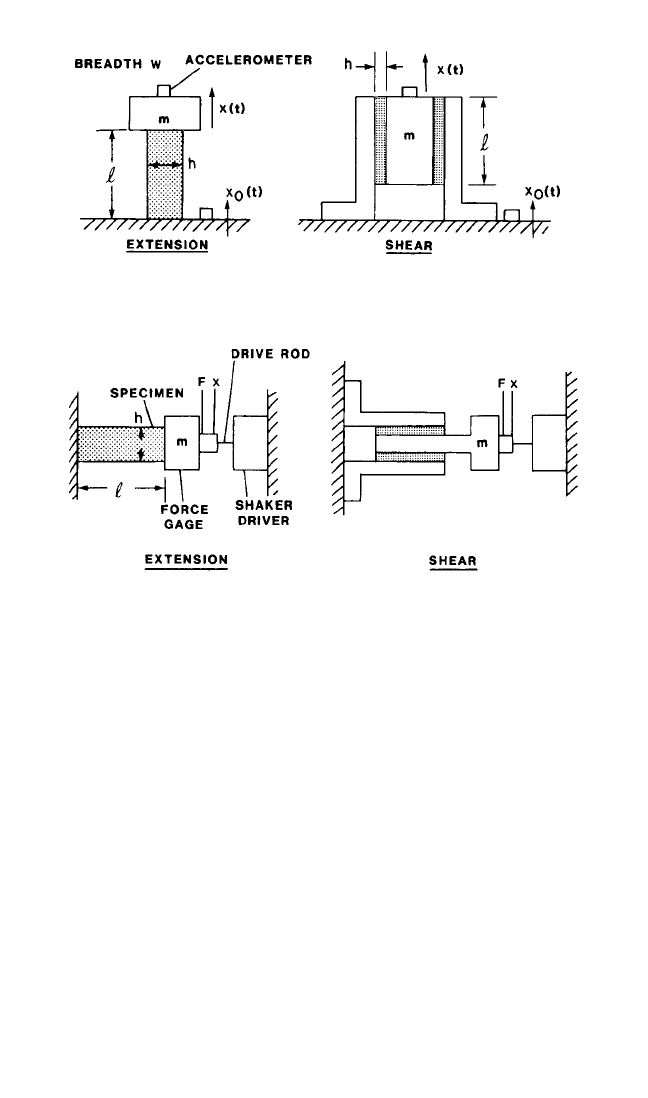
specimen material may be necessary, particularly for tests at high strain amplitudes
where internal heating of the specimen by energy dissipation from damping may
lead to wide differences between true specimen temperature and the temperature of
the surroundings.
Impedance Tests. If the specimens are excited by a driver through a force gage,
then the response measure used to characterize the system behavior is the compli-
ance or receptance x/F, where F is the driving force measured by the force gage and
x is the response at the same point, measured by an accelerometer, for example. If
the mass m is large compared with the mass of the specimen, as illustrated in Fig.
37.14, then one may add one-third the mass of the specimen to m to give the effec-
tive mass m
e
of the equivalent single degree-of-freedom system, so that
= (37.28)
If this is expressed instead in terms of the ratio F/x, the dynamic stiffness at the driv-
ing point, which is directly related to the driving-point impedance, then
κ=k − m
e
ω
2
+ jkη (37.29)
which shows that the direct dynamic stiffness is a linear function of ω
2
and the quad-
rature dynamic stiffness κ
Q
= kη. It is not difficult to obtain good measurements of k
1
k(1 + jη) − m
e
ω
2
x
F
APPLIED DAMPING TREATMENTS 37.21
FIGURE 37.14 Impedance test concepts.
FIGURE 37.13 Resonance test concepts.
8434_Harris_37_b.qxd 09/20/2001 12:27 PM Page 37.21

and η by this type of test approach from about 0.2ω
r
to 3ω
r
, so data can be obtained
quite easily over about a decade of frequency instead of at only a single frequency as
for the resonance method. Analytical mass corrections may also have to be made to
account for inertial effects at the force gage.
COMMERCIAL TEST SYSTEMS
Many commercial systems are available for measuring the complex modulus prop-
erties of viscoelastic damping materials.
11–13
All are based on some kind of deforma-
tion mode of a sample of the material, measurement of the corresponding excitation
forces and displacements, and analysis of the data to obtain the material properties.
Each system has advantages and disadvantages, but when due care is exercised, good
results usually can be obtained with each system. Particular care should be taken to
read, understand, and follow the manufacturer’s instructions. For example, in some
tests such as monitoring cure cycles of epoxies, the temperature sweep rate can be
quite high in order to keep up with the reaction.This is acceptable if one is monitor-
ing the progress of the cure cycle, but it may not be acceptable if one seeks to mea-
sure the damping properties at a state approximating thermal equilibrium. For
thermal equilibrium to be maintained, temperature sweep rates well below 1°F
(0.5°C) per minute are usually recommended, and even lower rates may be required
for large specimens. A dwell period at each temperature is recommended before
performing the test.
REFERENCES
1. Nashif, A. D., D. I. G. Jones, and J. P. Henderson: “Vibration Damping,” John Wiley & Sons,
Inc., New York, 1985.
2. Nashif, A. D., and T. M. Lewis: Sound & Vibration, 25(7):14 (1991).
3. Williams, M. L.: J. AIAA, 2(5):785 (1964).
4. Bagley, R. L., and P. Torvik: J. Rheology, 27(3):201 (1983).
5. Ferry, J. D.: “Viscoelastic Properties of Polymers,” 3d ed., John Wiley & Sons, Inc., New
York, 1981.
6. Jones, D. I. G.: “Handbook of Viscoelastic Vibration Damping,” John Wiley & Sons, Ltd.,
Chichester, U.K., 2001.
7. Harris, C. M.: “Shock and Vibration Handbook,” 4th ed., The McGraw-Hill Companies,
Inc., New York, 1996.
8. Oberst, H.: Akustica, 4:181 (1952).
9. “DampFEA Beam Test System,” Roush Anatrol Corp., Sunnyvale, Calif.
10. “DTI VBT Beam Test System,” Damping Technologies, Inc., Mishawaka, Ind.
11. “Viscoelasticmeter Impedance Test System,” Metravib S. A., Ecully, France.
12. “DuPont DMP Flexural Impedance Test System,” DuPont Instruments,Inc.,Wilmington,
Del.
13. “PL-DMTA Impedance Test System,” Polymer Laboratories, Ltd., Loughborough, U.K.
37.22 CHAPTER THIRTY-SEVEN
8434_Harris_37_b.qxd 09/20/2001 12:27 PM Page 37.22

CHAPTER 38
TORSIONAL VIBRATION IN
RECIPROCATING AND
ROTATING MACHINES
Ronald L. Eshleman
INTRODUCTION
Torsional vibration is an oscillatory angular motion causing twisting in the shaft of a
system; the oscillatory motion is superimposed on the steady rotational motion of a
rotating/reciprocating machine. Even though the vibration cannot be detected with-
out special measuring equipment, its amplitude can be destructive. For example,
gear sets that alter speeds of power transmission systems transmit the vibration to
the casing. Similarly, slider crank mechanisms in engines and compressors convert
torques to radial forces that are discernable to human perception but are not meas-
urable because of the insensitivity of test equipment and background noise. If gear-
boxes or reciprocating machines are part of a drive train, excess noise and vibration
can indicate trouble. Standards and measurement methods dealing with acceptable
magnitudes of radial vibration are provided in Chap. 19.
Motion is rarely a concern with torsional vibration unless it affects the function of
a system. It is stresses that affect the structural integrity and life of components and
thus determine the allowable magnitude of the torsional vibration.Torsional vibratory
motions can produce stress reversals that cause metal fatigue. Components tolerate
less reversed stress than steady stress. In addition, stress concentration factors associ-
ated with machine members decrease the effectiveness of load-bearing materials.
Figure 38.1 illustrates the twisting of a shaft of an electric motor-compressor sys-
tem. The torsional mode shape associated with the first torsional natural frequency
is shown in Fig. 38.2. A coupling in the power train allows for misalignment in the
assembly. The mode shape shows that the stiffness of the coupling is much less than
that of other shaft sections. This is indicated by the large slope (change in angular
displacement) of the mode shape at the coupling.The coupling will be the predomi-
nant component in the motor-compressor system governing the torsional natural
frequency associated with the mode.
Torsional vibration is usually a complex vibration having many different fre-
quency components. For example, shock resulting from abrupt start-ups and unload-
38.1
8434_Harris_38_b.qxd 09/20/2001 12:25 PM Page 38.1

ing of gear teeth causes transient torsional vibration in some systems; start-up of
synchronous electric motor systems may cause torsional resonance. Random tor-
sional vibrations caused by gear inaccuracies and ball bearing defects are relatively
common in rotating machines.
MODELING
The torsional elastic system of a drive unit and its associated machinery is a com-
plicated arrangement of mass and elastic distribution. The complete mechanical
system can include the drive unit, couplings, gearboxes or other speed-changing
devices, and one or more driven units. This complicated system is made amenable
to mathematical treatment by representing it as a model—a simpler system that
is substantially equivalent dynamically. The equivalent system usually consists of
lumped masses which are connected by massless torsionally elastic springs as illus-
trated in Fig. 38.3. The masses are placed at each crank center and at the center
planes of actual flywheels, rotors, propellers, cranks, gears, impellers, and arma-
tures.
1
The torsional calculation is made not for the drive unit alone but for the com-
plete system, including all driven machinery. On an engine, it is usually possible to
consider such parts as camshafts, pumps, and blowers either as detached from the
engine (if they are driven elastically) or as additional rigid masses at the point of
attachment to the crankshaft (if the driver is relatively rigid). If there is doubt, these
parts should be included in the torsional calculation as elastically connected masses
and removed if the natural frequencies do not change after the parts are removed
from the model.
38.2 CHAPTER THIRTY-EIGHT
FIGURE 38.1 Schematic drawing illustrating the twisting of
the shaft of a motor-compressor system.
FIGURE 38.2 Torsional mode shape for the motor-
compressor system shown in Fig. 38.1.
8434_Harris_38_b.qxd 09/20/2001 12:26 PM Page 38.2
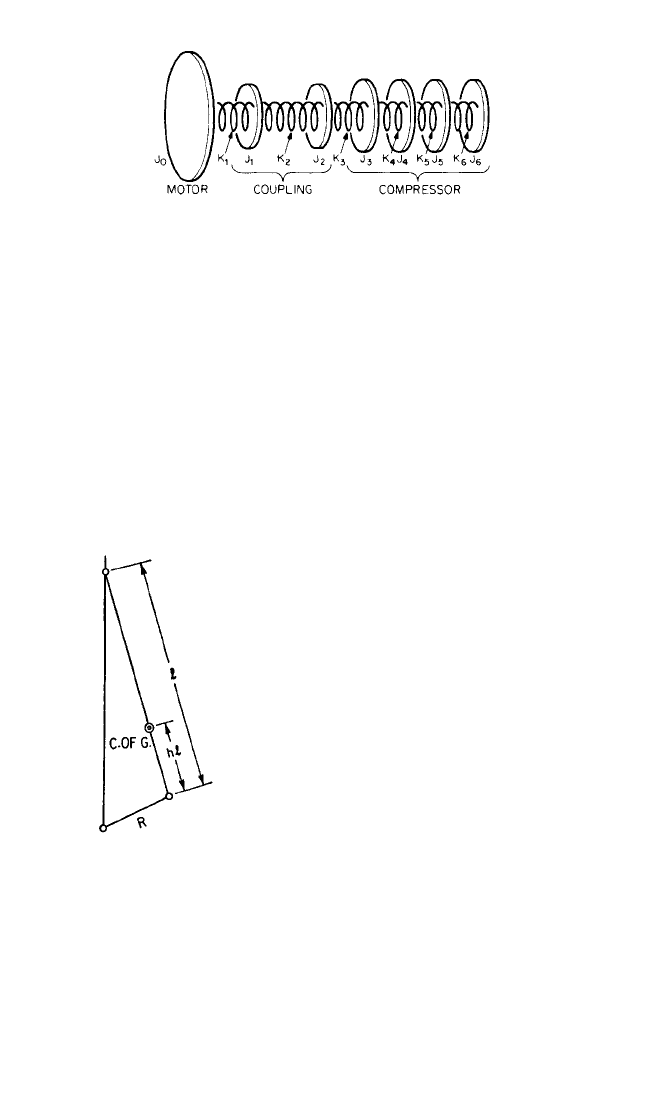
CALCULATION OF POLAR MOMENTS OF INERTIA
Circular Disc or Cylinder Rotating about a Perpendicular Axis. The polar
moment of inertia, essential in modeling torsional vibration, often is easy to calcu-
late.The general form is J =∫r
2
dm, where r is the instantaneous radius, and dm is the
differential mass. The formula for the polar moment of inertia of a circular disc or
cylinder rotating about a perpendicular axis is
J = lb-in.-sec
2
(38.1)
where J = polar moment of inertia,
lb-in.-sec
2
γ= material density, lb/in.
3
d = diameter of disc or cylin-
der, in.
l = axial length of disc or
cylinder, in.
g = acceleration due to gravity,
386.1 in./sec
2
Piston and Connecting Rod. The pis-
ton and connecting rod shown schemati-
cally in Fig. 38.4 introduce a
variable-mass problem, the solution of
which is complex. The exact solution
shows that the effect of the piston and
connecting rod can be closely approxi-
mated by representing them as a concen-
trated rotor of polar inertia J defined by
J =
+ W
c
1 −
lb-in.-sec
2
(38.2)
where W
P
= weight of piston, piston pin, and cooling fluid, lb
W
c
= weight of connecting rod, lb
h = fraction of rod length from crank pin to center-of-gravity
R = crank radius, in.
R
2
g
h
2
W
P
2
πd
4
lγ
32g
TORSIONAL VIBRATION IN RECIPROCATING AND ROTATING MACHINES 38.3
FIGURE 38.3 A model of the motor-compressor
system shown in Fig. 38.1, consisting of a series of
masses connected by massless torsionally elastic
springs (K = stiffness, lb⋅in./rad; J = polar moment of
inertia, lb⋅in.⋅sec
2
).
FIGURE 38.4 Schematic diagram of a crank
and connecting rod.
8434_Harris_38_b.qxd 09/20/2001 12:26 PM Page 38.3
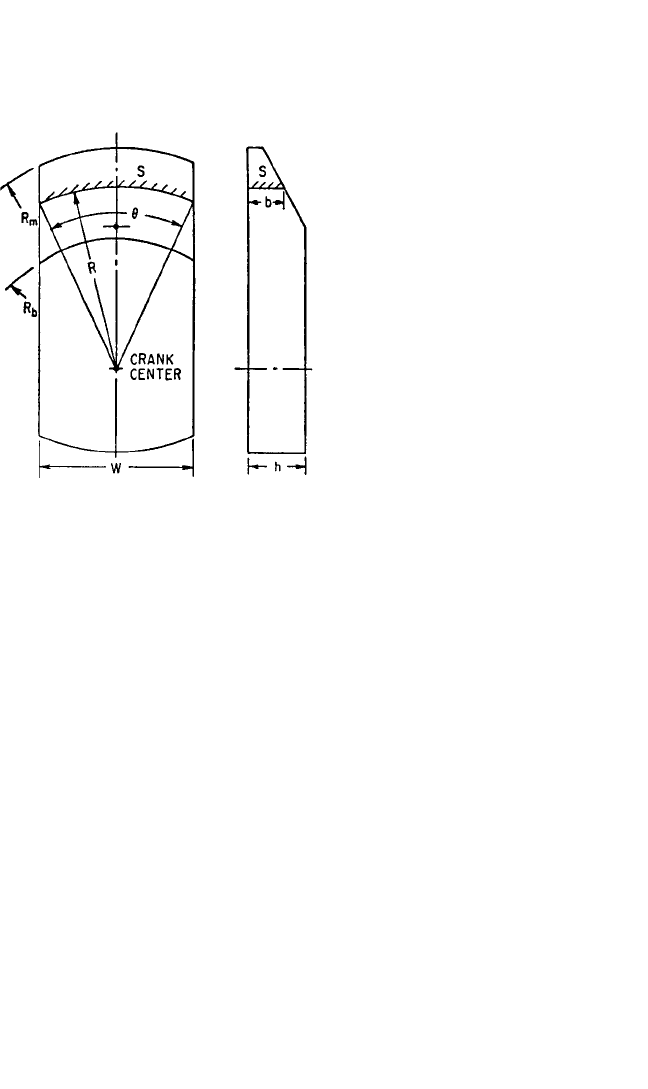
Crankshaft. The polar inertias of the crank webs (see Fig. 38.5), the crankpin,
and the journal sections are added to that given by Eq. (38.2). These polar inertias
should be calculated with the best
obtainable accuracy. The following pro-
cedure is recommended:
Let the crank web be intercepted by
a series of concentric cylinders of radius
R. The polar inertia of the crank web is
defined by
J =
R
m
R
b
R
2
S dR
+ J
b
(38.3)
where γ=specific weight of the
crank web, lb/in.
3
R
m
= maximum radius of the
crank web, in.
R
b
= radius of base cylinder
(see Fig. 38.5), in.
J
b
= polar inertia of portion
of crank web within base
cylinder, lb-in.-sec
2
The integral in the above expression for
J is the area of the R
2
S curve between
the values of radii R
b
and R
m
.
For the crank web shown in Fig. 38.5 the area S is defined as S = bRθ/57.3, where
is measured in degrees. The polar inertia can then be expressed as
J =
R
m
R
b
bR
3
dR
+ J
b
lb-in.-sec
2
(38.4)
The same procedure is used to calculate the polar inertia of propellers and other
irregular parts. In a marine propeller of ogival sections, i.e., flat driving face, circular
arc back, and elliptically developed outline (do not use for other shapes), the polar
inertia (excluding hub) is given by
J = 0.0046 lb-in.-sec
2
where n = number of blades
D = diameter of propeller, in.
b = maximum blade width, in.
t = maximum blade thickness at one-half radius (axis to tip), in.
Propellers. For propellers, pumps, and hydraulic couplings an addition must be
made for the virtual inertia of the entrained fluid. For marine propellers this is ordi-
narily assumed at 26 percent of the propeller inertia. Virtual inertias for pumps are
not known accurately, but it can be assumed that half the casing is filled with rotat-
ing fluid.
nD
3
bt
g
γ
57.3g
γ
g
38.4 CHAPTER THIRTY-EIGHT
FIGURE 38.5 View of a crank web in a plane
normal to the crankshaft axis.
8434_Harris_38_b.qxd 09/20/2001 12:26 PM Page 38.4
